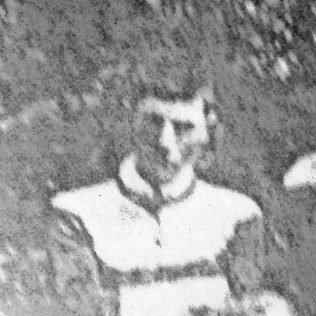
Photo A
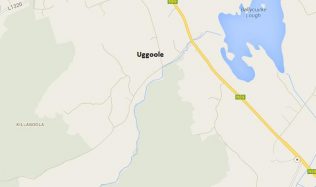
Map of Uggoole townland in Moycullen, John’s birthplace
The project below was completed by the 26 children of 6th class in Scoil Mhuire Moycullen over 2 months beginning in late January 2014 and finishing in late March 2014. During the course of the project the children discovered that historical research, while of course being important as part of their curriculum, can also be interesting in its own right. As they dug deeper into newspaper and military history archives they began to unearth facts that may have been common knowledge 80 years in our parish had been forgotten for one reason or another. Hopefully as you read through this project you will get sense of the enjoyment the children derived from researching and writing it.
Séan O Flaharta, Teacher.
John Geoghegan his life and death between 1912 and 1921 in Moycullen Co. Galway
John Geoghegan is mainly remembered in Moycullen and Galway for his involvement in the nationalist cause and his untimely death. In this project we will look at his life; his work as a farmer and later a rural district Councillor, his interests; hurling, football and the Irish language, his nationalism; as a 1918 election canvasser and Irish Volunteer. We hope to understand what life was like for a young man at this turbulent time in our history. We ask questions about the circumstances of his death and hopefully have done something to life the veil of secrecy and intrigue about his death.
Rugadh John Geoghegan I Maigh Cuilinn sa bliain 1893. Rugadh é I Uguala I Maigh Cuilinn , báile fearthainn atá ar an mbóthar go dti Gaillimh. Ghlac John páirt sa Cogadh Neamspleachas ó 1919 go dtí 1921 nuair a dúnmharú é. Tá an tionscnamh seo faoi an tionachar a bhí ag saol ghearr John ar Maigh Cuiilinn

Moycullen
John (1893) was the eldest boy in the family. He had two older sisters Catherine (1889) and Sarah (1891), He had five younger siblings; William (1895) Thomas (1896), Delia-Mary (1897), Margaret, (1898), Michael, (1900), Edward (1903) (1).
His father William was born in 1841 and he was a member of the R.I.C. until he retired and became a farmer. He had come from Laois and settled in Galway, where he married Margaret Lee and had ten children, two deceased before 1911. Every child except Catherine was a scholar and everyone in the family could speak Irish and English. They were also all Roman Catholic.(3).
His mother Margaret, born in 1861 was a Roman Catholic. He attended Scoil Mhuire Moycullen and St. Josephs secondary school known as the “Mon” in Galway city. (25.) When his father died John took over the “comfortable” farm.(23)
John’s birthplace
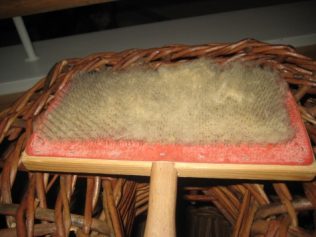
Photo B. Wool puller

Photo C. Hen’s Nest
We don’t have much direct information on John Geoghegan’s own farming career but we do know what farming life was like Farming back then was very hard work. They had no machinery which made it very hard. In Moycullen there are two parts of land Taobh Mín [Smooth Side]. and Taobh Garbh [Rough Side] (4). These are divided by the main Galway – Clifden road. John Geoghegan was on Taobh Garbh which was considered the bad part of land. On Taobh Garbh many crops were sown like rhubarb, potatoes, oats, barley, turnips, onions and cabbage (5). John Geoghegan was a well-known farmer from Uggoole. $map2 He had 50 acres of land. He had cows, sheep, horses and pigs. His main breeds of cow were Angus and black and white heads. He mainly sowed rhubarb, oats and turnips, he didn’t sow barley. His brother Tom {who inherited the farm after the death of John} had a secret for growing very tasty rhubarb. Many people questioned him about his secret, but he would never tell. We now know his secret, in the winter when there was lots of frost he would cover his rhubarb in reeds and it would then protect the rhubarb from the frost. John sold his crops in the fair in Galway. He used horses for ploughing. For fertilizer he used burnt lime and guano. According to local sources he was a very good farmer and was very successful.
Moycullen Now…
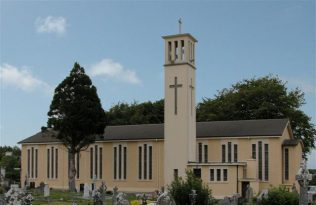

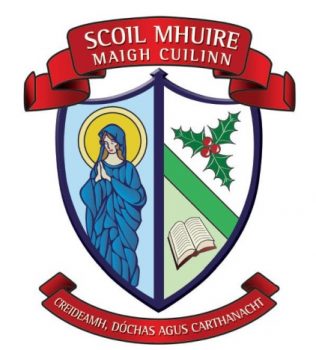


Moycullen Then…

Photo E

Photo F.
The Gaelic Athletic Association

Photo G.
The Gaelic Athletic Association is an Irish amateur sporting and cultural organisation, focused primarily on promoting Gaelic games, which include hurling, camogie, Gaelic football, handball and rounders(8). The GAA also promotes Irish music and dance, and the Irish language (9).The GAA in Moycullen was set up in 1912 and John Geoghegan was on the first team to win the trophy (John Geoghegan is circled in red). This was where his interest in Nationalism was fostered. He received a small silver medal when he and his team won the west Galway championship for Gaelic football. He preferred Gaelic football to hurling and was the starting goalkeeper for his team, he was the right corner back in hurling.
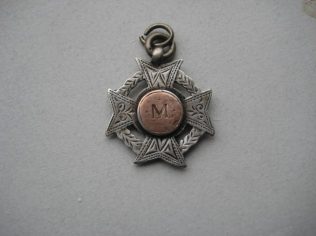
Photo H.
John Geoghegan’s medals are still on display in the Moycullen GAA club (3). In Sept 1916 age 23, John was playing for Moycullen vs Oughterard in the Junior Championship (10). We can see at this time life for John was similar to life today playing the local sports against the local rivals Oughterard much like today. But unlike the typical young person of today, politics was much more important and more vital and also we are quite sure more exciting and definitely more dangerous. The GAA was at the centre of this when in 1914 a resolution was passed calling on all club members to support the Irish Nationalist Volunteers (24). The founding member of the GAA in Moycullen was Padhráic Thornton who in 1916 was the Captain of the local Irish Volunteers unit. The GAA like we will see with Conradh na Gaeilge later on had a large membership and for many people this was where radicalisation with respect to the National Question began.
Conradh Na Gaeilge
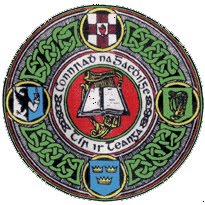
Conradh Na Gaeilge is an Irish organisation founded by the first Irish president Douglas Hyde in 1883. In 19213 John Geoghegan was a member of Conradh Na Gaeilge before he was shot. He joined in 1915 (28) and was still a member up until he died. The aims of Conradh Na Gaeilge were to preserve the Irish language, to promote Gaelic literature and to promote Gaelic writing.
There was a very strong connection between the GAA, the Irish Volunteers and Conradh na Gaeilge (13), as this picture taken in Galway in 1913 of the Conradh Oireachtas where you have Padhráic Pearse, Eamonn Ceannt {who incidentally was born in the same house as a father of one of the children} (27) and Seán McDermott as well as Padhráic Thornton {all highlighted} who was the Captain of the Moycullen branch of the Irish Volunteers in 1916 of which John Geoghegan was a vital member. In Moycullen at the time it seems that membership of the three organisations mentioned was taken as given.
Conradh Na Gaeilge is still very strong in Moycullen today organising Irish language classes as summer camps which 300 children from the parish would attend every July (14).

John Geoghegan joins the Irish Volunteers
The Irish volunteers were a military organisation established in 1912 (15). Its aim was to secure and maintain the rights and liberties common to the people of Ireland. The Gaelic league, ancient order of Hibernians and Sinn Fein were included in the Irish volunteer’s organisation, although the IRB were secretly involved.
Liam Mellows was sent from Volunteer HQ to organise the Volunteers in Galway and is remembered locally in Moycullen for having a motorbike (2).
The 1916 rising

Photo J – Irish Volunteer
The 1916 rising was one of the most important events in the history of modern Ireland (15). In some parts of the country mainly Dublin, Galway and Meath Irish volunteers rose against the Crown forces.
1916 Galway
Liam Mellows organised the volunteers for 1916 (16). There were 500 men who were from South Galway mainly, they organised a number of attackers and marched to Ardrahan (17). They asked for 42 guns from the Moycullen branch of the Irish Volunteers due to either a breakdown in communication 24 or the Moycullen volunteers being unwilling to mobilise they did not rise in Moycullen (17).
Black and Tans
The Black and Tans were recruited in Great Britain in 1919 (12). The Black and Tans are often confused with the Auxiliary Division a counter-insurgency unit of the RIC made up of former British officers, but the Tans were a different force. Their name came from the colour of their uniform. In Moycullen John Geoghegan was one of the first men to join the Irish volunteers. Most men joined the Volunteers for the camaraderie. The Irish volunteers in Moycullen were led by Padhráic Thornton. John Geoghegan was the quartermaster with responsibility for arms and messages.
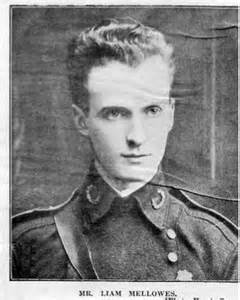
Liam Mellows
In 1918 John had canvassed for Sinn Féin locally because he was so well known in his own local area and in 1920 he was elected as a Rural District Councillor for Moycullen. We know this because there are reports in The Connacht Tribune at that time of the council having a minutes silence after his death for their esteemed colleague (26).
The Volunteers mostly marched around illegally drilling (11). Illegal drilling is when men dress up in uniforms and march around with rifles. There are reports of 52 men illegally drilling in Sleeveneena (18). The Moycullen volunteers were part of the East Connemara brigade for the War of Independence as this stage they were under the command of M. Ó Droighneán from Spiddle with John Geoghegan acting as Quartermaster. Geoghegan acted as an intermediary for O Droighneán at this time and O Droighnean was in regular contact with Michael Collins (19). Indeed on the day of Geoghegan’s death he received a message from Volunteer HQ in Dublin from Captain Jim Byrne. This was for O Droighneán.
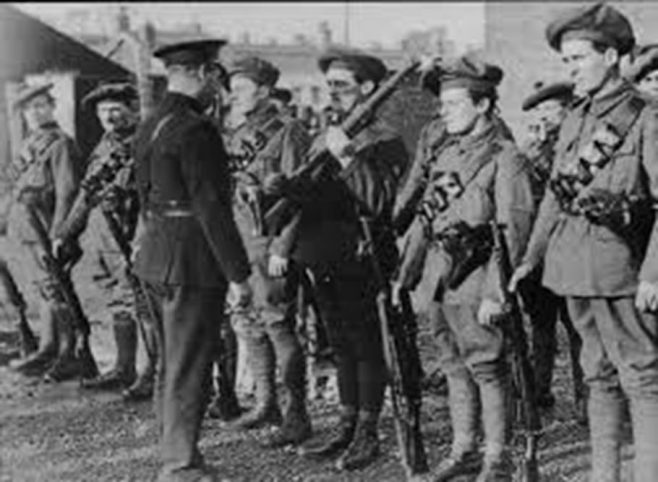
Photo I. Black and Tans
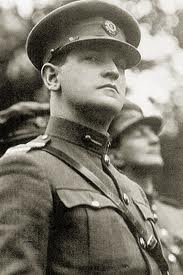
Michael Collins
The Irish War of Independence began in 1919. The main leaders were Michael Collins and Eamon de Valera. Collins led the guerrilla warfare with the formation of flying columns of Irish Volunteers, the East Connemara column of which John was a member.
In the months preceding the murder of John Geoghegan two incidents occurred which may have had a connection to his death (20). The first was the court-martial and subsequent execution of P.W. Joyce a national school teacher in Barna. He was accused of being a spy for the Crown Forces and was arrested and shot by the East Connemara brigade. John Geoghegan had been involved in this execution by bringing a priest from Shrule to give Joyce the last rites. In retaliation a local priest called Fr Griffin was killed by the Black and Tans a month later on November the 15th and then Geoghegan himself was shot 3 months later.
18.How John Geoghegan was murdered.
A newspaper report from the time said that the family was awakened by the sound of knocking and breaking glass (23). Someone shouted from outside “we want John Geoghegan “. Two men, one wearing a black coat with a police cap, the other wearing khaki and a tin hat, wielding a rifle came in and told John Geoghegan to get dressed and come with them. They accused him of being a friend of Michael Collins. His body was found by his mother and sister lying shot dead. There was a track left by a small motorcar on the road. There are local reports that both men spoke with Irish accents (2).
“I was horrified at the sad news, and I accompanied them to the house. There he was, stretched on the kitchen floor, his trousers and coat on, but no shoes. He was shot through the head. Fr. Cunnane {curate in Moycullen at the time} anointed him. This would be roughly an hour after he had been shot. Michael, his brother, told me they had all gone to bed when the Tans knocked loudly on the door. They were let in, and they told John to get up at once. While pulling on his trousers, he managed to whisper to Michael that the dispatch he had for me was stuck in a cock of hay in the haggard. He went out to the cock o’ hay there and then, and, after some time, found the dispatch and handed it over to me.”
BUREAU OF MILITARY HISTORY, 1913-21
Mícheál Ó Droighnean,
Furbough,
County Galway
On a side-note during research for this project two of the children discovered that their great great grandfather and his brother happened to come across John’s shooting and death (21). They were never questioned and therefore could have had some vital information on his murder.
John’s life was similar in many ways to our lives in Moycullen today 24 out of 26 us attend Conradh summer camp most years, we are all GAA members 10 of us come from farms but in other ways was are very different, we are not that interested in politics and we do not have to worry about being killed because of politics and also our standard of living in general is better.
The aftermath of the death of John Geoghegan

Photo M.
As can be seen from the excerpts below there was little sympathy from the Irish government for John Geoghegan’s mother’s plight (22).
On Thursday the 17th of July Thomas Ó Conaill asked the minister of finance if whether the claim for compensation on behalf Mrs Margret Geoghegan who lived in Ugool Moycullen in respect of her son John Geoghegan who was murdered on February 1921 by British forces. Also Mrs Geoghegan states that her house and crop were completely destroyed and lots more of her possessions were looted. In the end Mrs Margret Geoghegan only received fifty pounds from the Red Cross, but she received no compensation from the minister of finance also no grant was made for the funeral expenses.
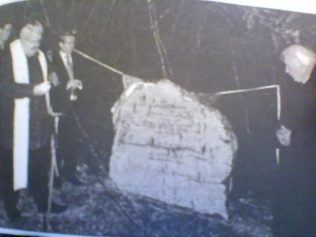
Photo N. Memorial to John unveiled 2004 Sean Kyne T.D. and Enda Kenny T.D
Most of his family moved to the USA, his brother had a shop in Newcastle G and L stores. Tom who inherited the farm never married and today there are 30 houses on his land. A window in the church commemorates John sponsored by oTom but apart from that and his memorial John Geoghegan is remembered in Moycullen today for his farming, his Conradh membership for being the first goalkeeper the hurling club had but above all for his death and more so for the way he died.
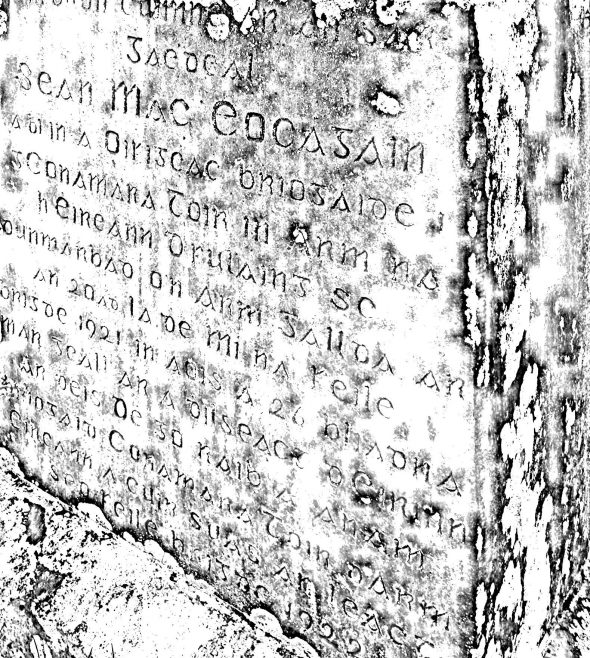
Photo P.
REFERENCES
#1 1901 Census
#2 1911 Census
#3 Craobh Mhaigh Cuilinn de Chonradh na Gaeilge: Treasa Mhic Mhathúna
#4 Annie O’Brien {primary contemporary source}
#5 Micheal Walshe {primary contemporary source}
#6 The Moycullen matters Magazine
#7 Hardiman history of Galway
#8 GAA a Peoples history: Mike Cronin
#9 Cumann peil Maigh Cuilinn
#10 Connacht Tribune Saturday 21/9/1916
#11 County Inspector’s, Office, Galway 1st may 1913
#12 Ireland 1912-1985 Politics and Society Lee
#13 Galway Advertiser November 28 2013
#14 Conradh na Gaeilge Maigh Cuilinn
#15 History Quest 6
#16 Historical survey of Ireland and Revolution in Connacht by Cormac ó Comhraí
#17 Military History Bureau {MBI} of Ireland: Thomas Hynes and Thomas Courtney
#18 MBI: M Ó’droighnean
#19 MBI: Pat Callanan
#20 An Tathair o Gríofa: Padhráic O’Laoi
#21 Nora Cooke
#22 Houses of the Oireachtas Thursday, 17 July 1924
#23 Freeman’s Journal 21/02/21
#24 Galway Politics and Society 1910-1923;Tomás Kenny
#25 Irish Independent 25/02/1921
#26 Connacht Tribune 29/3/21
#27 Prionsios Maughan –primary source 31/3/14
#28 Craobh Maigh Cuilinn Conradh na Gaeilge
Figures
Fig 1. National Museum of Ireland – Country Life, Castlebar
Fig 2. National Museum of Ireland – Country Life, Castlebar
Bibliography
Primary sources
Interviews:
Michael Walshe 24/2/2014
Michael Flaherty 1/3/2014
Annie o Brien 12/6/2012
Marie Boran 8/3/2014
Kieran Hoare 8/3/2014
Catherine O Brien 24/2/2014
Nora Cooke 12/3/2014
Prionsios Maughan 31/4/14
Newspapers:
Freeman’s Journal 21/02/1921
Connacht Tribune 21/9/1916
County Inspector’s report security 1/5/1913
Military bureau of Ireland history section
First hand interviews with Volunteers Thomas Hynes, M Ó Droighneán, Pat Callanan, Thomas Courtney accessed at www.bureauofmilitaryhistory.ie
Historical Survey of Ireland
Secondary Sources
History Quest 6— {Fallons} 2003
Moycullen Matters magazine 25/6/2011
Craobh Maigh Cuilinn – Treasa mhic Mathúna published by Conradh na Gaeilge 1981
Ireland 1912-1985 Politics and Society—J. Lee {Cambridge University Press} 1980
An tAthair ó Gríofa –Padhráic ó Laoi {the Author.} 1994
GAA- a Peoples history – Mike Cronin {Collins Press} Collins Press 2009
Revolution in Connacht—Cormac ó Cómhraí {Mercier Press} 2013
Maigh Cuilinn a Muintir Moycullen Historical Society 2008
Galway Politics and Society Tómas Kenny
Four Courts Press 2011
Hardiman’s history of Galway Claddagh Press 1820
Acknowledgements
We as a class would like to sincerely thank the following people for all the help that they have given us:
John Cox – NUIG Library
Marie Boran- NUIG Archive Section
Kieran Hoare- NUIG Archive Section
Micheal Walshe
Micheal Flaherty
Annie O Brien
Brian Wall
Louise Walshe
Manon O Halloran
National Museum of Ireland – Country Life
Anne Newell
Prionsios Maughan
Nora Cooke
Maurice Whelan
Marcus Thornton
Cumann Luthcleas Gael Maigh Cuilinn
Conradh na Gaeilge Maigh Cuilinn
Marie Walshe
Anne Reidy
Dympna McDonough
A very special thank you to Catherine O Brien without whose expertise and guidance this would not have been possible
Go raibh maith agaibh ó Rang a Sé Scoil Mhuire
Katie H., Katie O K., Hannah, James W., James C., Róisín, Seán, Eoin, Mark, Niamh, Rita, Lauren, Nicholas, Amy, Maeve, Maria, Robyn, Sarah, Tessa, Jakub, Conor, Cathal, Dónal, Aislinn, Sorcha, Troy
Photo References
a Moycullen GAA
b Museum of Country Life
c Museum of Country Life
d Scoil Mhuire
e
f
g Moycullen GAA
h Moycullen GAA
I Galway Advertiser
J generic
K generic
L generic
M Catherin O’Brien
N Catherine O’Brien







No Comments
Add a comment about this page